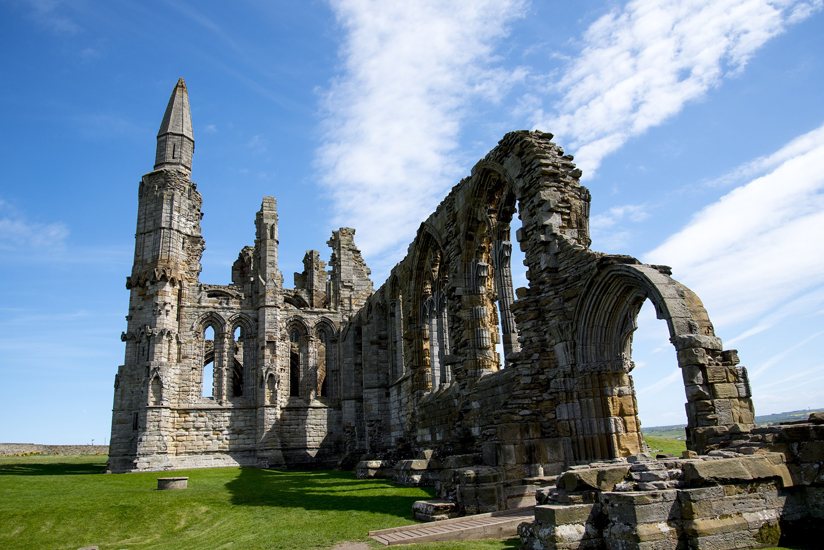Whitby Abbey was a 7th-century Christian monastery that later became a Benedictine abbey. The abbey and its possessions were confiscated by the crown during the Dissolution of the Monasteries under Henry VIII. The abbey church was situated overlooking the North Sea on the East Cliff above Whitby in North Yorkshire, England – United Kingdom.
The substantial ruins of the church have been declared a Grade I Listed building and are in the care of English Heritage, while its site museum is housed in Cholmley House.
The first monastery was founded in 657 AD by the Anglo-Saxon era King of Northumbria, Oswy (Oswiu) as Streoneshalh (the older name for Whitby). He appointed Lady Hilda, abbess of Hartlepool Abbey and grand-niece of Edwin the first Christian king of Northumbria, as founding abbess. The name Streoneshalh is thought to signify Fort Bay or Tower Bay in reference to a supposed Roman settlement that previously existed on the site. This contention has never been proven though and alternative theories have been proposed, such as the name meaning Streona’s settlement. Some believe that the name referred to Eadric Streona, but this is highly unlikely for chronological reasons: Streona died in 1017 so the naming of Streoneshalh would have preceded his birth by several hundred years.
In 664 the Synod of Whitby took place at the monastery to resolve the question of whether the Northumbrian church would adopt and follow Celtic Christian traditions or adopt Roman practice, including the manner of calculating the date of Easter and form of the monastic tonsure. The decision, with the support of King Oswy, as was for adopting Roman practices. Streoneshalch monastery was laid waste by Danes in successive raids between 867 and 870 under Ingwar and Ubba and remained desolate for more than 200 years. The existence in the area of a locality named ‘Prestebi’, recorded in the Domesday Survey, may be a sign that religious life was revived in some form after the Danish raids since in Old Norse it means a habitation of priests. The old monastery given to Reinfrid comprised about 40 ruined monasteria vel oratoria similar to Irish monastic ruins with numerous chapels and cells.
Reinfrid, a soldier of William the Conqueror, became a monk and travelled to Streoneshalh, which was then known as Prestebi or Hwitebi (the “white settlement” in Old Norse). He approached William de Percy who gave him the ruined monastery of St. Peter with two carucates of land, to found a new monastery. Serlo de Percy, the founder’s brother, joined Reinfrid at the new monastery which followed the Benedictine rule. The second monastery lasted until it was destroyed by Henry VIII in 1540 during the Dissolution of the Monasteries. Though the abbey church was stripped and fell into ruin, it remained a prominent landmark for sailors and helped inspire Bram Stoker’s Dracula. The ruins are now owned and maintained by English Heritage.
In December 1914, Whitby Abbey was shelled by German battlecruisers Von der Tann and Derfflinger who were aiming for the Coastguard Station on the end of the headland. Scarborough and Hartlepool were also attacked. The Abbey buildings sustained considerable damage during the ten-minute attack. Whitby Abbey was rendered famous in fiction by Bram Stoker’s 1897 novel Dracula, as Dracula there came ashore as a creature resembling a large dog and proceeded to climb the 199 steps which lead up to the ruins. Abbey possessions : The original gift of William de Percy not only included the monastery of St. Peter at Streoneshalch, but the town and port of Whitby with its parish church of St. Mary and six dependent chapels at Fyling, Hawsker, Sneaton, Ugglebarnby, Dunsley, and Aislaby, five mills including Ruswarp, the town of Hackness with two mills and the parish church of St. Mary, and the church of St. Peter at Hackness ‘where our monks served God, died, and were buried,’ and various other gifts enumerated in the ‘ Memorial’ in the abbot’s book. Priors and abbots : The first prior, Reinfrid, ruled for many years before being killed in an accident. He was buried at St Peter at Hackness. He was succeeded as prior by Serlo de Percy
Access : Coordinates: 54.489, -0.608 / By train : Whitby 1?2 mile , By bus : Esk Valley service 97 & 97A actually serve Whitby Abbey Location : Abbey Lane, Whitby, North Yorkshire, YO22 4JT , Opening times : Monday to Sunday: 10.00 – 17.00 Winter opening times vary. PARKING : Car park located 100 metres from the abbey , Prices : £7.90 – £22.60
Events : LET’S GO FLY A KITE Sat 30 Jun – Sun 1 Jul 2018 , Captain Cook Sat 7 – Sun 29 Jul 2018, every weekend (except 14 & 15) , Hands on History: Ahoy! Mon 23 Jul – Sun 3 Sep 2018, every day except event weekends , LET’S GO FLY A KITE Sat 30 Jun – Sun 1 Jul 2018 , Captain Cook Sat 7 – Sun 29 Jul 2018, every weekend (except 14 & 15)
Hands on History: Ahoy! Mon 23 Jul – Sun 3 Sep 2018, every day except event weekends
Outdoor Theatre: A Midsummer Nights Dream Wed 1 Aug 2018 , Dracula Sat 4 – Sun 19 Aug, every weekend , Vikings! Sat 25 – Mon 27 Aug 2018 , Dracula Sat 1 & Sun 2 Sep 2018 ,
Nearby Attractions : The wreck of the Admiral Von Tromp / Whitby Lighthouse / Sandsend Beach / Caedmon’s Cross

